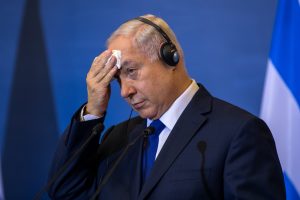by Paul R. Pillar
First son-in-law Jared Kushner has been tantalizing onlookers so long with a yet-to-be-announced plan for resolving the Israeli-Palestinian conflict that it is hard to remember when the tantalizing began. The process has appeared to be an exercise in buying time. The recent Israeli election, probably as much as anything else, has governed Kushner’s schedule. It suited Prime Minister Benjamin Netanyahu not to have to address, before the vote, any proposal from the United States that even hinted at anything that could be construed as an Israeli concession. With that election now over, the big reveal may be near. Kushner suggested as much in a recent appearance at the Washington Institute for Near East Policy. On earlier occasions he had suggested he might release his plan after the Muslim holy month of Ramadan, which ends in the first week of June.
The reasonable thing to do in most cases of a not-yet-announced proposal is to wait for the announcement so that one can address what is definitely in the proposal rather than relying on fragments and probabilities based on press reports. But reasonableness does not prevail on this issue—or on many things from Washington lately, for that matter. The nation has just had a big lesson on the effects of advance spinning, in the form of Attorney General William Barr’s misrepresentation of Special Counsel Robert Mueller’s report. The advance spin in Kushner’s case is that his proposal is indeed a “peace” plan that, if implemented, really would have a chance of resolving the Israeli-Palestinian conflict. It is appropriate to assess now, based on the fragments and probabilities, whether that is true, rather than just sitting back and watching more of the spinning.
A purported leak of the plan appeared a few days ago in the Israeli newspaper Yisrael Hayom. The paper explicitly does not vouch for the authenticity of what it printed, and Kushner’s Trump administration colleague Jason Greenblatt has dismissed the report as “inaccurate” and “just speculation.” No analysis should run very far with the leak, but the purported plan does conform with most of the earlier fragments and probabilities.
The basic contours of the Israeli-Palestinian conflict, and the possibilities for resolving it, have long been well known. The alternatives for resolution are a two-state solution, entailing the establishment of a predominantly Arab Palestinian state to exist alongside a predominantly Jewish state of Israel, or a one-state solution, entailing equal political and civil rights for all residents of the land Israel currently controls. Those are the only possibilities. Anything else is not a resolution of the conflict but instead a perpetuation of it, and of the subjugation of one people by another that characterizes the conflict. These facts are reflected in the oft-cited trilemma in which Israel can be any two of three things but not all three: a Jewish state, a democratic state, and a state controlling all the land between the Mediterranean and the Jordan River.
A two-state solution has the attraction of being the most complete fulfillment of the nationalist aspirations of both Jewish Israelis and Arab Palestinians. It also would fulfill the international community’s charter for the future of Palestine, going back to the United Nations General Assembly’s partition plan of 1947. In any case, there is no whiff of possibility in current Israeli politics of moving toward the equality of rights for all that would be required for a one-state solution.
But Kushner, as suggested by some of his comments at the Washington Institute, is not embracing a two-state solution either. His proposal evidently involves perpetuating, not resolving, the Israeli-Palestinian conflict. A principal reported feature is getting Gulf Arabs to pony up enough aid to make Palestinian life in the West Bank slightly less uncomfortable than it is now. The purported plan published in Yisrael Hayom envisions an entity called “New Palestine” that falls far short of the attributes of a state. It would consist of disconnected small enclaves in territory under Israeli control and would even have to pay Israel for maintaining the only military force in the area. As Jonathan Cook notes in a detailed examination of the leaked document, what is envisioned is a minor modification of the status quo. New Palestine would be a slightly revised version of the current hapless Palestinian Authority.
Underlying Motivations
The direction of the proposal is not surprising given the overall policy to date of the Trump administration on matters involving Israel and the Palestinians. That policy has been one of giving the Netanyahu government whatever it wants while punishing and rebuffing the Palestinians in almost every way possible. That punishment has included—as an indication that the administration has no desire even to talk to the Palestinians—closing both the U.S. consulate in Jerusalem (which functioned as the de facto U.S. diplomatic mission to the Palestinians) and the Palestinian diplomatic office in Washington. The spin that has attempted to portray some of these moves in peace process terms is easy to see through. For example, the administration’s declaration of Israeli sovereignty over all of Jerusalem and the moving of the U.S. embassy there did not take the issue of Jerusalem “off the table.” It instead shoved the entire table toward one side in the dispute and out of reach of the other side. The table may have been moved, but the issue is still festering.
The nature of the proposal also is not surprising in view of Kushner’s deep, longstanding personal attachment to Israel and to Israel’s current leadership. As a teenager, Kushner once slept in the basement so that a visiting Benjamin Netanyahu—a personal friend of the Kushner family—could sleep in Jared’s bedroom. The family’s many other attachments have included direct support for Israeli settlements in the occupied West Bank. Personal connections to an overseas situation, and the knowledge that comes with it, sometimes can be useful in a diplomatic endeavor. (For example, Zalmay Khalilzad’s Afghan background, in addition to his diplomatic experience, suits well his current role of trying to negotiate an end to the Afghan civil war.) But it is hard to think of another person besides Kushner (along with Greenblatt and U.S. Ambassador to Israel David Friedman) who, with zero diplomatic experience, is so deeply embedded on one side and not the other side of a conflict that he supposedly is mediating on behalf of the United States.
The plan behind the plan evidently is based on the assumption, probably correct, that Palestinian leaders will quickly reject Kushner’s proposal. Then the Netanyahu government and the Trump administration can add the episode to a favorite narrative according to which the Palestinians keep rejecting “peace” offerings. And the Israeli government can go full speed ahead with more construction of settlements in the West Bank and further cementing of Israeli control over the territories.
Even if—in some strange act of political suicide—Palestinians leaders were to sign on to such a proposal, it would not resolve the conflict. History—especially, in Palestinian minds, the huge displacement or nakba of 1948, as well as the occupation stemming from the Six-Day War of 1967—does not get forgotten, as the histories of many other conflicts demonstrate. Nationalist aspirations do not vanish through buying off of people who hold them. And even with a buy-off, the pains and frustrations of subjugation remain. Even if the West Bank were to remain quiet for a time, the open-air prison known as the Gaza Strip would not, as the world recently has been reminded.
The destructive effects are not limited to the Israeli-Palestinian theater. The plan is increasing the Trump administration’s dependence on Arab dictatorships. The Persian Gulf monarchies are supposed to provide most of the development money. According to the recently leaked version of the plan, the regime of Egyptian strongman Abdel Fattah el-Sisi will lease land in the Egyptian Sinai for use as an airport and industrial zone next to the Gaza Strip. The increased dependence means the Trump administration will do even more of the bidding of these authoritarian regimes than it already has. For Egypt, this includes the ill-advised attempt to designate the Muslim Brotherhood as a terrorist organization. For Saudi Arabia and the United Arab Emirates, it means continuing support for the disastrous war in Yemen and steps that increase the risk of a U.S. war with Iran.
Emboldening the Israeli Right
One way in which the Kushner plan might generate some further movement, though not in the direction Kushner and the administration intend, is that it will so embolden the Israeli right wing, even further than Trump’s policies have already emboldened it, that it formally annexes much of the West Bank and drops some of the fictions that have long characterized Israeli postures regarding the conflict with the Palestinians. Kushner’s host at the Washington Institute, Executive Director Robert Satloff, opposes the plan for this reason. Satloff foresees a sequence in which Kushner’s plan leads to annexation which leads to a mobilization of international diplomacy against the Israeli actions, a drop in American public support for Israel, and various other consequences such as the Saudi regime taking advantage of the situation for its own not very admirable purposes.
Many of the political dynamics involved in such a sequence would be between Netanyahu and members of his right-wing coalition who are even more extreme than he is. As Satloff accurately observes, “the shrewd and risk-averse Netanyahu would most likely prefer to find a way to keep the murky status quo, in which Israel maintains security control over the entire West Bank and channels support to many existing Israeli settlements while holding out the admittedly dim prospect of a diplomatic resolution with the Ramallah-based Palestinian Authority.”
This reasoning may be behind the recent leak. Yisrael Hayom is the free-distribution newspaper that casino magnate Sheldon Adelson bought to support his friend Bibi and that is widely regarded as a mouthpiece for Netanyahu. The leaked document is unlikely to have been published without Netanyahu’s concurrence and possibly active involvement. The most plausible explanation is that the prime minister calculated that backlash against the ugly nakedness of the fully fleshed-out Kushner plan would defer yet again its formal release and enable his government to continue indefinitely the fiction of an eventual diplomatic resolution while solidifying its control of occupied territory.
Satloff is with Netanyahu on this and seems satisfied with the murky status quo. But that status quo means continued subjugation, strife, and bloodshed. It means perpetuation of the conflict rather than resolution of it. It is not the best alternative available, but a better alternative would come into play only if Israel were to dissipate the murkiness, squarely face the trilemma, and choose democracy as one of the two things it will be.
In the meantime, whether the months ahead see more of the status quo or a slightly modified version of it under the Kushner plan, Israel will continue, as Netanyahu has said, to “live by the sword.” That’s not peace.






Sadly, the one alternative Israel Will choose to ignore is Democracy. Jewish State and control over Judea and Samaria are core elements that a majority are voting for in this recent election. Perpetuation of the current mess is inevitable as the Palestinians have lost even the semblance of real support from their Arab Brothers. Hamas has dug a very deep hole with Bibi’s shovel. But to get out, they first must stop digging (firing missiles). And find better friends than Iran. Hunker down, this is not going to end soon.
Want to know what’s in Kushner’s plan. Since we cant post links go look up the Jerusalem Summit org.. There you will find the plan that’s been waiting around for years for just such a perfect storm as having Kushner and Trump in the WH…..Kushners plan will be a version of this with some differences….but the same intent.
Its called ‘The Humanitarian Approach to the Palestinian issue .”
First they say Palestines are not capable of having a state. But they want to be humane to the Palestines. So no “Two States”
You really have to read it to see the mentality behind it . Its like ghouls planning the wedding of a corpse.. .
The writer has a remarkable insight into the intractable problem that has existed for decades, his analysis is correct and he can see through what “appears” to be a Peace Plan….
At this stage there is no two state solution.There is hardly anything left. Right now the PA only serves Israel as a fig leaf to deny them rights while taking over their land. The PA should disband and let the Palestinians demand equal rights as citizens in a one state solution. Just the thought of Palestinians gaining equal rights will change their thinking, if not it will expose them more as an apartheid state.
The author ignores the long and clear history of this conflict as arising from the continuing Arab refusal, throughout time, to accept the right of a nation state of the Jewish People to exist in any part of its ancestral homeland. That is why there has been no solution. That is why there is no solution. That is why there are no prospects for a solution in the foreseeable future. A legitimate question to ask, if the goal is “two states for two Peoples” (something the Arabs refuse to enunciate) why is the already existing Palestinian Arab majority state, sitting on 80% of the area of historic Palestine, not enough? Why do the Arabs need a second “homeland”?